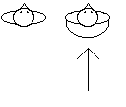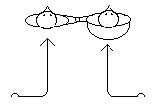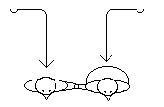Starting Position

Bars 9-11

Bar 12
(2nd time)
-
Beat 3: Bring left foot even to right,
Beat 4: Lower to flat,
Beat 5-6: Pause.

Bar 19

Section IV
(Both are facing up the hall, Man on left, as at the start of the dance.)

Alternate Section IV
| Steps: | Sempio (in 6), Doppio (in 6), Piva (in 4), Saltarello (in 6), Contrapasso (in 6), Ripresa (in 4), Meza Ripresa (in 4), Continenza (in 6), Mezavolta, Reverenza, Movimento. | Starting Position |
| Start: | Couple, side by side, Woman on the right, holding hands, facing up the hall. | |
 Bars 9-11 | ||
| [Introduction of 4.5 bars on accompanying tape] | ||
| 1 | Continenza Left, Continenza Right. | |
| 2 | Sempio Left, Sempio Right. | |
| 3 | Sempio Left. (Half-size bar) | |
| 4 | Doppio Right. |  Bar 12 |
| 5 | Reverenza Left. | |
| 1-5 (2nd time) | Repeat. | |
| 6 | Man Sempio Left, Sempio Right. | |
| 7-8 | Man Contrapasso Left, twice. For the last four beats of Bar 8, do the following:
Beat 4: Lower to flat, Beat 5-6: Pause. | |
| 9 | Woman Sempio Right, Sempio Left. | |
| 10-11 | Woman Contrapasso Right, twice. For the last four beats of Bar 11, do the following: Beat 3: Bring right foot even to left, Beat 4: Lower to flat, Beat 5-6: Pause. | |
| 12 | Sempio Left, Sempio Right, taking right hands, and switching places, Man ending with a Mezavolta Right. | |
| 13 | Reverenza Left. (Both are facing up the hall, Man on right.) | |
| 6-13 | (2nd time) Repeat, switching roles. (They end in the starting position.) |  Bar 19 |
| 14-17 | 8 Pive (each takes a half bar), starting Left. | |
| 18 | Man Movimento, then Woman Movimento. | |
| 19 | Ripresa, separating, so Man to the Left, Woman to the Right. |  Section IV |
| 20 | Woman Movimento, then Man Movimento. | |
| 21 | Meza Ripresa, separating, Man to Left, Woman to Right. | |
| 22 | Saltarello Left, turning to face at start, coming together and turning to face up the hall. Take hands. | |
| 23-25 | 3 Saltarelli, starting Right, together. (Both are facing up the hall, Man on left, as at the start of the dance.) | |
| (This is exactly the same as Section I, played only once.) | ||
| 26 | Continenza Left, Continenza Right. |  Alternate Section IV |
| 27 | Sempio Left, Sempio Right. | |
| 28 | Sempio Left. (Half-size bar) | |
| 29 | Doppio Right. | |
| 30 | Reverenza Left. | |
If the dance is repeated, Section V is only played the last time. For a repeat, the dance can either be done identically or the woman can lead from the left. If the second is preferred, the dancers should come together in Bar 22 but turn the other way, so that the woman is on the left side.
Recordings
Dances Courts 2 - Section I is played an extra time as an introduction. Section I is 5 bars long, instead of 4.5, with a half-bar added to the end; just pause. Bar 21 is a full bar in 4/4, so use a full ripresa instead of a meza ripresa. Quite slow, especially the piva section, and easy to follow.
To Celebrate - Short introduction. The bassadanza sections may be a bit hard to follow as they start with a lead-in, which is correct for bassadanza but can be confusing. (What sounds like the beginning of a bar is actually the lead-in to it. ) Bar 21 is a full bar in 4/4, so use a full ripresa instead of a meza ripresa. Section V is not included. The dance is played twice with one long note at the very end.
Dance Notes
Bar 4: PnD does not give a foot for this doppio, but using strict alteration, starting with the first continenza being on the left (which is specified), it would then be on the right. The reverenza that follows is on the left in all but one source, which is further evidence. However, all the sources except PnD say that the doppio is on the left.
Bars 7-8: PnG and some other sources say that the man does these turning toward the woman. This is not present in PnD, which has a mezavolta on the upbeat to Bar 12, satisfying the same purpose. See the note for Bar 12.
Bars 7-8, and 10-11: The time alloted for the two contrapassi is one and a half bars (which is one beat more than they actually need), as the entire section of two sempii and two contrapassi is specified in PnD as taking two and a half bars of bassadanza; however, the musical sources then have a half-bar of rest. We tried leaving the half-bar of rest out, but the resulting confusion in our dancers made us decide to retain it. We added the instructions for the rest of the bar, using what seems to happen naturally there.
Bar 12:

Alternate Mezavolta at Beginning of Bar 12, With Man in Forward Leading Position |
It is odd that the man is not also instructed to do a mezavolta at the end of the two sempii, in order to face forward again. This mezavolta has been added.
Bar 19: PnD says to separate with four passiti "per traverso", without mention of feet. NYp says to face one another and do a ripresa on the left. Sc also has a ripresa, the man going left and the woman right, with no mention of facing each other beforehand. The other four sources for this dance say to back up with three steps, some saying to face, others not. We decided that the four passitti done in traverso are equivalent to a ripresa, but otherwise followed PnD, presuming that the couple do not face, as no mention is made of it.
Bar 21: This section is similar to Bar 19, but in PnD and PnG the music is only half as long. The dancers continue to separate with the same steps used before (the one exception being Sc, which seems to have the dancers come together). However, the sources that call for three steps (PnA, PnG, Fn and Fl) say that the saltarello following starts on the third step, which we interpreted as meaning a half-bar with two steps, (or a meza ripresa when done sideways) and then starting the saltarelli on the third step. For PnG this works well, as a half-bar of music matches an apparent half-bar step. Unfortunately, PnD clearly calls for four passetti, has only half a bar of music, and doesn't mention starting the saltarelli early, while PnA has only three passetti, starts the saltarelli on the third one (i.e. after half a bar), but then has a full bar in the music. This entire section shows considerable variation in the different sources, and alternate reconstructions are very obviously valid.
Section V: PnD and PnG repeat the music for the first section again at the end, which is necessary in order to resolve the piece musically. None of the sources give any indication that the steps for the first section are to be repeated, but we decided to include them. It is possible that the music was meant to indicate that the dance should be repeated, but this would still leave the piece unresolved at the conclusion of the repeat.
Repeat: We chose not to have a repeat as, in this reconstruction, the dancers end as they started. The variation to use if the dance is repeated, with the woman leading from the left, is conjecture.
Music Notes

Except for the issues raised above, no changes were made to the music.